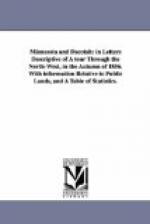M. Nicollet was a foreign gentleman who possessed superior scientific knowledge and a rare zeal to prosecute researches. He made an exploration through the valley of the St. Peter’s and the Missouri; and from thence to the sources of the Mississippi, in the year 1839. The official report which he made is a valuable document, but difficult to be obtained. I shall therefore make a few extracts from it. I should here remark that M. Nicollet died before he had completed the introduction to his report. “The Mississippi,” he says, “holds its own from its very origin; for it is not necessary to suppose, as has been done, that Lake Itasca may be supplied with invisible sources, to justify the character of a remarkable stream, which it assumes at its issue from this lake. There are five creeks that fall into it, formed by innumerable streamlets oozing from the clay-beds at the bases of the hills, that consist of an accumulation of sand, gravel, and clay, intermixed with erratic fragments; being a more prominent portion of the great erratic deposit previously described, and which here is known by the name of ’Hauteurs des Terres’— heights of land.
“These elevations are commonly flat at top, varying in height from 85 to 100 feet above the level of the surrounding waters. They are covered with thick forests, in which coniferous plants predominate. South of Itasca Lake, they form a semicircular region with a boggy bottom, extending to the south-west a distance of several miles; thence these Hauteurs des Terres ascend to the north-west and north; and then, stretching to the north-east and east, through the zone between 47 degrees and 48 degrees of latitude, make the dividing ridge between the waters that empty into Hudson’s Bay and those which discharge themselves into the Gulf of Mexico. The principal group of these Hauteurs des Terres is subdivided into several ramifications, varying in extent, elevation, and course, so as to determine the hydrographical basins of all the innumerable lakes and rivers that so peculiarly characterize this region of country.
“One of these ramifications extends in a southerly direction under the name of Coteau du Grand Bois; and it is this which separates the Mississippi streams from those of the Red River of the North.
“The waters supplied by the north flank of these heights of land— still on the south side of Lake Itasca— give origin to the five creeks of which I have spoken above. These are the waters which I consider to be the utmost sources of the Mississippi. Those that flow from the southern side of the same heights, and empty themselves into Elbow Lake, are the utmost sources of the Red River of the North; so that the most remote feeders of Hudson’s Bay and the Gulf of Mexico are closely approximated to each other.”




